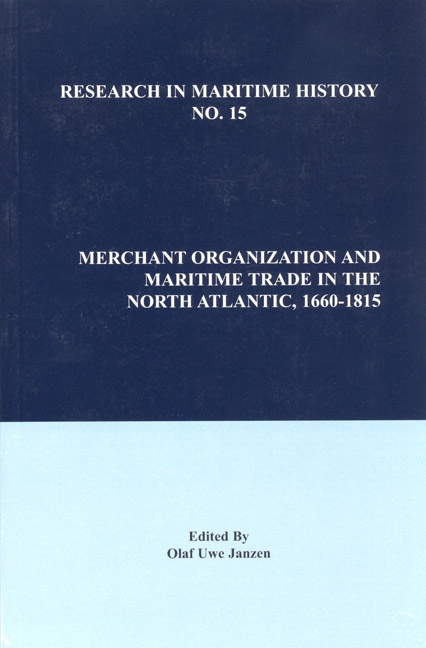Book contents
- Frontmatter
- Contents
- Contributors
- Preface
- CONTRIBUTIONS
- “Introduction”
- “The Gaigneur Clan in the Seventeenth-Century Canada Trade”
- “Credit, Risk and Reputation in Late Seventeenth- Century Colonial Trade”
- “The Huguenot Diaspora and the Development of the Atlantic Economy: Huguenots and the Growth of the South Carolina Economy, 1680-1775”
- “Breaching the Mercantile Barriers of the Dutch Colonial Empire: North American Trade with Surinam during the Eighteenth Century”
- “A Scottish Venture in the Newfoundland Fish Trade, 1726-1727”
- “The Consolidation of Bilbao as a Trade Centre in the Second Half of the Seventeenth Century”
- “Cutting Out The Middleman? American Trade In Northern Europe, 1783-1815”
- “A Vital Link in Wartime: The Organization of a Trade and Shipping Network Between the United States and Bordeaux, 1793-1815”
- “The Challenge of War on Maritime Trade in the North Atlantic: The Case of the British Trade to Iceland During the Napoleonic Wars”
“A Scottish Venture in the Newfoundland Fish Trade, 1726-1727”
from CONTRIBUTIONS
- Frontmatter
- Contents
- Contributors
- Preface
- CONTRIBUTIONS
- “Introduction”
- “The Gaigneur Clan in the Seventeenth-Century Canada Trade”
- “Credit, Risk and Reputation in Late Seventeenth- Century Colonial Trade”
- “The Huguenot Diaspora and the Development of the Atlantic Economy: Huguenots and the Growth of the South Carolina Economy, 1680-1775”
- “Breaching the Mercantile Barriers of the Dutch Colonial Empire: North American Trade with Surinam during the Eighteenth Century”
- “A Scottish Venture in the Newfoundland Fish Trade, 1726-1727”
- “The Consolidation of Bilbao as a Trade Centre in the Second Half of the Seventeenth Century”
- “Cutting Out The Middleman? American Trade In Northern Europe, 1783-1815”
- “A Vital Link in Wartime: The Organization of a Trade and Shipping Network Between the United States and Bordeaux, 1793-1815”
- “The Challenge of War on Maritime Trade in the North Atlantic: The Case of the British Trade to Iceland During the Napoleonic Wars”
Summary
On the afternoon of 8 June, 1726, as it was making its way north through Pentland Firth between the Scottish mainland and the Orkney Islands, the merchant ship Christian of Leith was struck by a storm. The ship's master, Alexander Hutton, was obliged to bear away and make for the shelter of Kirston Harbour, anchoring there at 5 pm. Not until 14 June did the winds shift sufficiently to allow the Christian to get underway once again. Finally, two days later and nearly two weeks after departing Leith, the ship's supercargo, Edward Burd Jr., was able to record in his journal with some satisfaction that the Christian had come abreast of the lonely rock of St. Kilda. Ahead lay the open Atlantic and their destination, Newfoundland.
The unscheduled stop in the Orkneys had almost certainly come as a relief to Burd, for he had been troubled by sea-sickness during the Christian's first days at sea. Yet the men who had chartered the ship would have viewed the delay at Kirston as an inauspicious beginning to a commercial venture which, by its novel nature, was filled with uncertainties. Stowed in the Christian's hold were five tons of “Bisquett” in thirty-two casks, which the supercargo was to sell in Newfoundland; he was then to purchase a cargo of fish for delivery and sale in Spain, where the acquisition of yet another cargo, consisting of cork, wine, and fruit, was to be arranged for the final leg back to Scotland. It was a dramatic departure from the kind of venture in which the investors had previously engaged, for not one of them had ever traded to Newfoundland — indeed, no Scottish merchant had ever participated regularly in the Newfoundland fish trade before the Christian began her voyage. Yet the men who chartered the ship were not complete novices in maritime commerce. All were experienced both in domestic enterprise and in maritime trade with Europe. Moreover, they were linked by an informal but advantageous network of social, political and commercial contacts through which they could safely respond to new commercial opportunities like the Newfoundland trade. This paper will therefore consider the social, economic and political environment which drew them into the Newfoundland trade at this time, as well as the circumstances of the voyage which seemingly convinced them not to repeat the experiment.
- Type
- Chapter
- Information
- Publisher: Liverpool University PressPrint publication year: 2017



